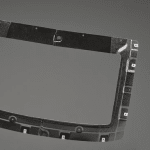 Engineers increasingly are using Tepex performance composites from Lanxess subsidiary Bond-Laminates to significantly improve the mechanical strength of components made of fiber-reinforced thermoplastic compression molding compounds. The latest example is a cover on the rear muffler of the BMW i8. It is fabricated in a direct long fiber thermoplastic (DLFT) process from a polypropylene compression molding compound reinforced with long glass fiber rovings. An insert made of Tepex dynalite 104-RG601 is used as the surface layer. "With its stiffness at high temperatures, it ensures that the cover undergoes no deformation or failure in the hot environment of the rear muffler. What is more, our composite improves the strength and impact resistance of the component in freezing temperatures," explained Harri Dittmar, composites expert at Bond-Laminates.
Engineers increasingly are using Tepex performance composites from Lanxess subsidiary Bond-Laminates to significantly improve the mechanical strength of components made of fiber-reinforced thermoplastic compression molding compounds. The latest example is a cover on the rear muffler of the BMW i8. It is fabricated in a direct long fiber thermoplastic (DLFT) process from a polypropylene compression molding compound reinforced with long glass fiber rovings. An insert made of Tepex dynalite 104-RG601 is used as the surface layer. "With its stiffness at high temperatures, it ensures that the cover undergoes no deformation or failure in the hot environment of the rear muffler. What is more, our composite improves the strength and impact resistance of the component in freezing temperatures," explained Harri Dittmar, composites expert at Bond-Laminates.The Tepex insert is 0.5 millimeters thick and made of a polypropylene matrix, incorporating 47 percent by volume continuous glass fiber rovings as a single-layer fabric. "Thanks to this insert, the stiffness of the cover increases by a factor of four at room temperature and a factor of six at the operating temperature of the rear muffler," explained Dittmar. Impact resistance benefits as well. In penetration tests to DIN EN ISO 6603-2, the Tepex dynalite formulation used proved to be eight to nine times more impact resistant at room temperature than a DLFT compression molding compound based on polypropylene. "At temperatures of -30 °C, the impact resistance is even 10 times higher - DLFT based on polypropylene will splinter under these conditions in a crash, our Tepex will not," Dittmar said.
Tepex also is an attractive option for locally reinforcing components made of other thermoplastic compression molding compounds and forming materials. For example, the mechanical properties of Tepex-reinforced DLFT polypropylene materials are on par with glass-mat-reinforced and glass-fabric-reinforced thermoplastic systems (GMT and GMTex) based on polypropylene. "In this case, the combination of Tepex with the DLFT process opens up considerable savings potential, for instance in the fabrication of underbody components," Dittmar explained. Polypropylene-based, low-weight reinforced thermoplastics (LWRT), which are used to manufacture underbody panels due to their high sound absorption, can also be significantly stiffened with Tepex surface layers. Using a single-layer Tepex component preserves the acoustic effect. "The result is components that can easily withstand the mechanical loads associated with road traffic."




